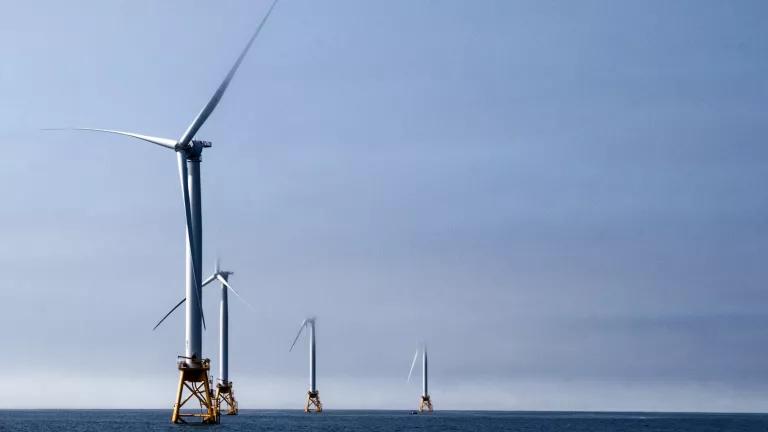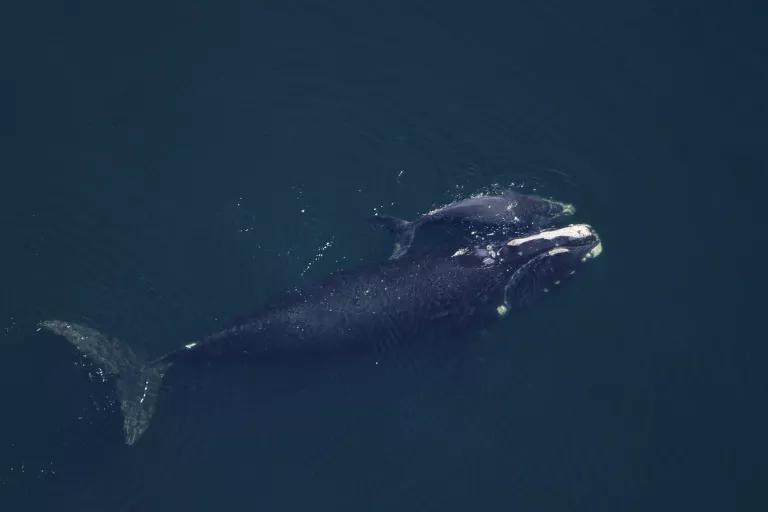The Race to Develop Offshore Wind—and Protect Endangered Whales
As Northeast states make impressive commitments to this clean energy source, scientists are helping them stay out of the way of marine mammals.

Block Island Wind Farm, off the coast of Rhode Island
It’s been only about two years since wind turbines began spinning in U.S. waters. Block Island Wind Farm, the country’s first offshore wind project, came online with five turbines in December 2016, powering 17,000 homes on the small island that had been disconnected from Rhode Island’s main grid and was relying on dirty diesel.
But in that short time, this single, 30-megawatt project has revolutionized thinking about the viability of this clean energy source to help meet our pressing climate goals. And more tangibly, it set the stage for a recent explosion in offshore wind commitments from states throughout the Northeast.
“Block Island really opened people’s eyes to how offshore wind energy can help communities along the coast—not just in terms of climate change, but also in terms of putting people to work,” says Aileen Kenney, senior vice president of development at Deepwater Wind, the company behind the Block Island Wind Farm. The U.S. Department of Energy (DOE) estimates the offshore wind industry could support 160,000 jobs (and power 31 million homes) by 2050; for its part, Deepwater employed nearly 300 locals for the relatively small Block Island project. The company is now expanding to other sites throughout the region; in addition to a second project off the coast of Rhode Island, it’s in contract with Connecticut and New York. All together, the three projects would provide an additional 690 megawatts of wind power.
As the momentum for offshore wind continues apace, it has also sparked a swift response from—and an unusual partnership with—the marine science community. In 2012, NRDC and various other environmental groups worked with Deepwater Wind to ensure that the developers would commit to protecting sensitive marine ecosystems within their planning phases. Stressing that the Northeast’s coastal waters are teeming with wildlife, biologists say the offshore wind industry must build on the protective measures put in place for the Block Island project to ensure that marine mammals aren’t harmed by development activities, especially the loud noises associated with driving steel piles (the foundations for some types of turbines) hundreds of feet into the ocean floor. Manmade noises from these sorts of industrial activities can drown out the sounds that whales and other marine mammals rely on for life's most basic functions, from navigating to mating.
Of particular concern is the endangered North Atlantic right whale, whose survival is already threatened by ship strikes and frequent entanglements in fishing gear. The whale had rebounded after centuries of hunting, but today only 450—and 100 breeding females—remain. Estimates indicate that the species could go functionally extinct (with the small remaining numbers being unable to sustain their population) within the next 20 years. Right whales are particularly sensitive to underwater noises, and scientists fear that the animals could be diverted off their typical migration course into areas that are not suitable for feeding, or even into shipping lanes, if the industry doesn’t take proper precautions to protect them.

“Our main goal is to advance environmentally responsible offshore wind development, and we’ve been focusing on the North Atlantic right whale given that it’s in such a dire conservation state,” says Francine Kershaw, a scientist at NRDC who advocates for marine mammal protection. “We are concerned that any additional stress could be quite damaging and impede its ability to recover.”
That’s why Kershaw and her NRDC colleagues, together with the National Wildlife Federation and the Conservation Law Foundation, have been working closely with the scientific community, including Scott Kraus at the New England Aquarium, to establish a set of best practices for the offshore wind industry to follow in pursuing new projects offshore the North Atlantic. The guidelines are geared toward addressing the three stages of wind farm development: site assessment, construction, and operations. They include a range of measures to better monitor for when whales are nearby so that activities don’t impact whales’ natural behaviors. There are also technological measures to reduce the sound impact, like using protective “bubble curtain” sleeves around the piles to diminish noise as they’re hammered down. Importantly, the best practices call for developers to avoid constructions during times of the year when whales are known to be feeding or migrating nearby. The team is currently negotiating with developers and expects to finalize the recommendations in the coming months, before the next wave of projects get underway.
Although the recommendations focus only on protections for the North Atlantic right whale, the Conservation Law Foundation’s Erica Fuller notes that they will aid other marine mammals, too, in what she calls “a trickle-down effect.” She adds that by working directly with developers like Deepwater Wind and Vineyard Wind (to which Massachusetts granted an 800-megawatt contract in May), the whale advocates are likely to reach a stronger agreement than they would by going through the Bureau of Ocean Energy Management. “It’s certainly in the project developers’ interests to mitigate as much as possible,” Fuller says. “They don’t want the bad press of a vessel hitting a right whale or noise creating a situation where [the animals] don’t stop to forage in very critical areas as they’re coming up the coast.”
With only the one Rhode Island project up and running off our coasts so far, there are many unknowns related to large-scale offshore wind development in this country. Europe, which already has 16,000 megawatts of offshore wind installed, can offer some lessons in best practices to manage such issues as reducing ocean noise and avoiding developments in key habitat. But Kershaw notes that Northern Europe (where most of the continent’s turbines are located) hosts significantly fewer large migratory whales than the U.S. coastline does. And while Europe’s many offshore wind farms have relied on guidance from scientific groups to ensure the safety of threatened small cetaceans, such as the harbor porpoise, they have not formulated measures specifically for the management of large whales.
To date, four states in the Northeast have made commitments to developing 8,600 megawatts of renewable energy, including more than 7,600 megawatts from offshore wind. Massachusetts will develop 800 megawatts in addition to the Vineyard Wind project for a total of 1,600 megawatts by 2027, while Rhode Island has committed to 1,000 megawatts of clean energy by 2020, a mix of offshore wind and onshore wind and solar. In January of this year, New York added a pledge to support 2,500 megawatts of offshore wind in Empire State waters by 2030. New Jersey committed to 3,500 megawatts by the same year. Nationally, the DOE expects U.S. offshore wind capacity to reach 22,000 megawatts by 2030.
Experts agree that it is critical to work out a successful approach now, in the early stages of wind development. “We can’t overstate the precedent we’re setting with this first round of projects,” says Catherine Bowes, the National Wildlife Federation’s Offshore Wind Energy program director. “It’s so important we get it right from the beginning.”
Deepwater Wind’s Kenney says there is widespread local support for offshore wind development, and this bodes well for the future of the industry in the United States. She says that residents and businesses along the Northeast coast—in towns like New Bedford, Massachusetts, for example—are eager to benefit from the economic boost that offshore wind can bring. In one of the hearings that preceded the creation of the Block Island Wind Farm, she recalls, a representative from a local labor union spoke in support of the project immediately after a staff member from the Conservation Law Foundation had done the same. “Someone in the union told me it was the first time in 15 years they’d spoken on the same side of an issue,” Kenney says. “It was pretty powerful.”
But the proposals have met opposition from some sectors. A 16-year-long dispute over Cape Wind, a wind farm planned for Massachusetts’s Nantucket Sound, ultimately derailed that project in 2017. Some of its main opponents were wealthy waterfront property owners, including the billionaire industrialist William I. Koch, who helped raise $40 million to stop the development as chair of the Alliance to Protect Nantucket Sound. Many commercial fishermen also see the turbines as an obstacle to their trade. The offshore wind developers and advocacy groups are working with the fishing industry to address some of its concerns about turbine placement.
In the end, Fuller says, “fishermen should be hugely concerned about climate change because their stocks are either moving north or to deeper waters. And then there are all the shellfish species vulnerable to ocean acidification.” Given this direct impact, a shift away from fossil fuels and toward renewable energy sources like wind will only benefit their livelihoods. “They really should be encouraging any effort to decrease greenhouse gas emissions as quickly as possible,” Fuller adds.
Bowes agrees. “The ocean is a resource, and a transformational amount of clean energy is one of its many gifts,” she says. “The potential is just undeniable and truly exciting for those of us kept up at night by climate change.” The more we harness the power of its winds, she notes, the more we’ll be able to help its creatures. We just need to make sure that it proceeds in a smart, responsible fashion. And this is a task that neither the scientists, nor the wind developers, nor the governments of the Northeast are taking lightly.
This NRDC.org story is available for online republication by news media outlets or nonprofits under these conditions: The writer(s) must be credited with a byline; you must note prominently that the story was originally published by NRDC.org and link to the original; the story cannot be edited (beyond simple things such as grammar); you can’t resell the story in any form or grant republishing rights to other outlets; you can’t republish our material wholesale or automatically—you need to select stories individually; you can’t republish the photos or graphics on our site without specific permission; you should drop us a note to let us know when you’ve used one of our stories.


Offshore Drilling in the Atlantic? “That’s Not Who We Are.”
How to Become a Community Scientist
In the Melting Arctic, a Reckoning to Save Indigenous Culture, Narwhals, and a Silent Sea